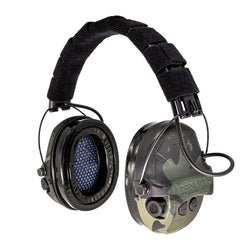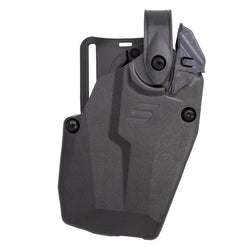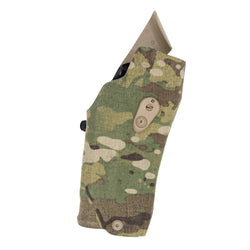Although largely relegated to quaint sections of museums and in untouched corners of fewer and fewer armories, the revolver legitimized the concept of the fighting handgun and remained in service well after viable and reliable semi-automatic pistols were adopted. Imperial powers like Britain, France, and Russia were early adopters of the revolver and continued to issue them well after World War II, long after they were superseded.
The American military’s first general issue was the Colt Dragoon, which was adopted by the Army shortly after the Mexican War in 1848. The military went away from revolvers with the adoption of the Model 1911, but wheel guns continued to be designed, bought, and issued to officers and enlisted men and women into the 1990s.
Here is a look at a few of the military revolvers in history and, with each subsequent generation, how the military revolver faded into obscurity.
The Colt Model 1860
Although Colt Manufacturing has become famous for clinging to legacy designs, its namesake, Samuel Colt was not one to rest on his laurels.
Colt patented his revolver in 1835 and, after trials and tribulations, managed to secure his first Army contract in 1848 with his .44 caliber Dragoon revolver. This all-iron six-shooter was powerful enough to floor a horse at full gallop and heavy enough that belt carry was impractical. It needed to be carried in pommel holsters on the saddle. Colt had success with his .36 caliber Navy pistol, which was sized just right for belt carry but smaller caliber.
In the 1850s, the Bessemer process had revolutionized the steel industry and made it possible for smelters to focus their attention on stronger, more specialized alloys including silver steel. Colt employed this new steel to create a more streamlined version of his Navy pistol, but upsized to .44 caliber. This new pistol had the desired power and was no larger than the Navy model. It was readily adopted by the US Cavalry in 1860, just in time to become the standard issue pistol of Union forces during the American Civil War.

The strengths of the Colt 1860 Army were undeniable, but it was a muzzleloading handgun in a war that saw the first breechloading cartridge guns come into use. The 1860 could be loaded with loose ball, powder, and percussion cap in separate steps, but the Army used paper cartridges. That sped up the reload, but those in the know learned to carry multiple pistols instead of bothering to reload.
This problem was not fully solved until the Colt 1860 was replaced with the adoption of the Colt Model 1873 in .45 Colt — itself an iconic military revolver in its own right that found greater fame among civilians and lawmen in the post-war era.
The M1895 Nagant
Double action revolvers were the next big evolutionary step.
Colt’s handguns, and most revolvers, have to be thumb-cocked in order to shoot. A double action revolver rotates the cylinder and fires with a long pull of the trigger that does both actions. This gave the shooter faster follow-up shots, whether facing one or multiple opponents.
Both sides of the Civil War fielded double action revolvers, but these were limited numbers of British and French designs. The domestically produced and adopted Starr was a failure. After the war, the US Army continued on with single action revolvers, but Europe gravitated towards double action revolvers as a rule.
The British Adams and French Chamelot Delvigne were just two prominent examples, but wares of Leon and Emile Nagant dominated European and international sales, with their M1895 Nagant as the final culmination of their design.

In an era of new and unproven swing-out cylinder revolvers, the M1895 Nagant was a robust gate-loaded seven shooter designed to take on the rigors of Czarist Russia. It used a unique gas-seal 7.62x38mmR cartridge that propelled a 110-grain bullet at over 1,150 feet per second — a hotrod for the day and roughly equivalent in power to the .32 H&R Magnum or .38 Special. The M1895 was Imperial Russia’s standard-issue revolver and it was retained after the Bolshevik Revolution in 1917.
The M1895 was superseded in the Soviet Union by the autoloading TT-30 and TT-33 Tokarev pistols in 1930 and 1933 respectively. But the Victorian-pistol-turned-Communist-icon remained in service as there were never sufficient numbers of the new pistol to go around as the Red Army geared up to counter German aggression in the early stages of World War II.
Slow to reload, yet foolproof, the Nagant remained in production until 1944 and was not relieved from duty until 1953 after the Makarov PM was adopted. Throughout the Soviet era, the M1895 was exported to sympathetic regimes worldwide including North Korea, China, and Vietnam.
The Webley
The Webley is a family of revolvers that served as the iconic sidearm of British and Commonwealth Forces from its first integration in 1889 until after World War II.
Webley & Scott of Birmingham pioneered their rapid-loading top-break revolver with the Webley Pryse in 1876. Subsequent improvements to the design led to the Webley Mk I, which was adopted by the British Army in 1887. The Mk I was a dense six-shooter with a compact bird’s head grip chambered in the .455 Webley cartridge.
Like their American counterparts, the Brits fielded large numbers of handguns in combat, and the .455 Webley round was an outlet to that reality. Like the .45 ACP, the .455 Webley is part of the slow and big class and was renowned for its stopping power over other rounds in use on the continent.
The .455 started out as a black powder cartridge but by the time of the First World War, the .455 was a smokeless cartridge chambered in the upgraded Mk. IV revolver. But the iconic British revolver is the Mk. VI, introduced in 1916. It featured a longer 6-inch barrel, wider combat sights, and a square butt grip to mitigate recoil.

With the Army’s expansion in the 1930s to head off the Nazi buildup, the government looked for a new round that was easier for conscripts to shoot while retaining the .455’s stopping power. The end result was the adoption of the Enfield No. 2 revolver in .38-200, a .38 S&W case topped with a heavy 200-grain lead bullet.
The .38-200 had promise but was neutered with the introduction of the nonexpanding 174-grain FMJ round over concerns of violating the Hague Accords. The Enfield was an obvious copy of the Webley Mk. IV .38 caliber revolver. Webley & Scott sued the government and thanks to the outbreak of World War II, the state had to buy the Mk. IV .38 due to a shortage of handguns.
The Webley Mk. IV and Mk VI revolvers continued in service through World War II and, due to budgetary restraints, the bankrupted British Empire would not part with their revolvers in exchange for the Browning Hi Power until 1963.
The Smith & Wesson M&P
Before the Smith & Wesson M&P name became synonymous with AR-15s and polymer pistols, an M&P was understood to be a .38 caliber K-frame revolver.
The M&P .38, later known as the Model 10, became the archetypical police handgun of the 20th century with over six million produced and manufacturing still ongoing. But militaries around the world also used the M&P concurrent to good pistols like the M1911 and Browning Hi Power.

The M&P entered production in 1899 as Smith & Wesson’s new medium frame swing-out cylinder entry. It was meant to compete with revolvers like the Colt New Army and New Navy, which were popular on the civilian market and were standard issue in the US Army as the M1892.
The story of the M&P usually starts, wrongly, with Smith & Wesson’s attempt to replace the M1892 in .38 Colt with a more powerful revolver after the .38 Colt cartridge was found lacking in power during the Philippine-American War. In reality, the war had only started by the time the M&P came off the line, but it did chamber a more powerful cartridge in the .38 S&W Special.
The US Army ultimately passed on the new M&P, preferring to skip to a .45 caliber revolver and then to a .45 ACP autoloader in the 1911. The M&P, chambered in .38-200, would be bought in large numbers by the British Purchasing Commission at the start of World War II.
The US government bought thousands of M&P revolvers and contracted with Smith & Wesson to produce a .38 Special 2-inch and 4-inch barreled version with a parkerized finish. That became known as the Victory Model. These handguns were issued to defense industry personnel at home and distributed heavily to the Coast Guard, Navy, and Marine Corps in lieu of the Model 1911.
The M&P line continued in service after the war, although Smith & Wesson changed their model names to numbers. The fixed-sighted M&P became the Model 10. In 1962, General Curtis LeMay authorized the issue of an adjustable sight version of the M&P as the standard USAF sidearm. That was the Model 15. These .38 Special revolvers were only phased out of service beginning in 1986 when the old M1911 was finally replaced by the Beretta M9 9mm pistol.
The Colt and Smith & Wesson Model 1917
When the United States declared war on Germany in April 1917 and entered the First World War, the Army had to transform from a small constabulary force to a one-million-man fighting machine.
The handgun had proven itself a valuable tool in trench warfare, as well as in its traditional role of arming the cavalry and other personnel who were unable to carry a rifle. The Army and Navy fielded the Colt 1911 automatic pistol in .45 ACP and now there was not enough of them to go around.
The Board of Ordnance authorized the issue of obsolete Colt New Service .45 Colt revolvers and Colt New Army .38 revolvers. But for logistics sake at the front lines, a new substitute was needed and it had to chamber the standard .45 ACP round. The government approached Smith & Wesson and Colt with the idea of chambering their existing large-frame revolver lines for that round.
Putting their rivalry aside, the companies did so. The .45 ACP was ideal for Colt’s New Service and Smith & Wesson’s .44 Hand Ejector Model. The main issue, however, was finding a way to extract the rimless .45 ACP cartridge using the hand ejector of the revolver.
Smith & Wesson came up with the half-moon clip, a steel tab that held three rounds that could be rapidly loaded into the cylinder two at a time for six rounds. These clips acted as a rim so the cartridges would load and eject in one clean motion.

Smith & Wesson shared its discovery with Colt and the pair produced what became known as the Model 1917 revolvers. Wartime production ended in 1920, with a total of over 300,000 revolvers made. The model acquitted itself well in combat and stocks of Colt and S&W 1917s continued to be issued as a substitute standard sidearm through World War II, the Korean War, and the Vietnam War.
Revolvers in Military Service
Aside from the occasional ancillary role, the revolver is no longer a military issue. But it is surprising how recently the revolver served, considering the first viable semi-auto pistols arrived more than a century ago.
The military revolver started as a replacement for single-shot pistols where six rounds were always going to be better than one. Later, the revolver got easier to load and quicker to shoot. With the dawn of the semi-auto, the revolver hung on. It was the default handgun in an era of change, could be kept fully loaded, and would work in confined conditions. In the absence of what was standard, the revolver was readily available and served admirably well towards the end of the Cold War.









